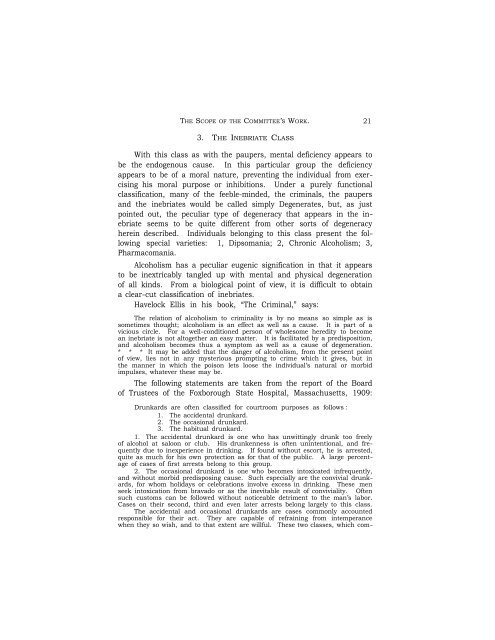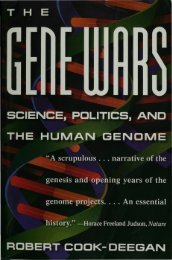Eugenics Record Office. BULLETIN No. 10A - DNA Patent Database ...
Eugenics Record Office. BULLETIN No. 10A - DNA Patent Database ...
Eugenics Record Office. BULLETIN No. 10A - DNA Patent Database ...
Create successful ePaper yourself
Turn your PDF publications into a flip-book with our unique Google optimized e-Paper software.
THE SCOPE OF THE COMMITTEE’S WORK. 21<br />
3. THE INEBRIATE CLASS<br />
With this class as with the paupers, mental deficiency appears to<br />
be the endogenous cause. In this particular group the deficiency<br />
appears to be of a moral nature, preventing the individual from exercising<br />
his moral purpose or inhibitions. Under a purely functional<br />
classification, many of the feeble-minded, the criminals, the paupers<br />
and the inebriates would be called simply Degenerates, but, as just<br />
pointed out, the peculiar type of degeneracy that appears in the inebriate<br />
seems to be quite different from other sorts of degeneracy<br />
herein described. Individuals belonging to this class present the following<br />
special varieties: 1, Dipsomania; 2, Chronic Alcoholism; 3,<br />
Pharmacomania.<br />
Alcoholism has a peculiar eugenic signification in that it appears<br />
to be inextricably tangled up with mental and physical degeneration<br />
of all kinds. From a biological point of view, it is difficult to obtain<br />
a clear-cut classification of inebriates.<br />
Havelock Ellis in his book, “The Criminal,” says:<br />
The relation of alcoholism to criminality is by no means so simple as is<br />
sometimes thought; alcoholism is an effect as well as a cause. It is part of a<br />
vicious circle. For a well-conditioned person of wholesome heredity to become<br />
an inebriate is not altogether an easy matter. It is facilitated by a predisposition,<br />
and alcoholism becomes thus a symptom as well as a cause of degeneration.<br />
* * * It may be added that the danger of alcoholism, from the present point<br />
of view, lies not in any mysterious prompting to crime which it gives, but in<br />
the manner in which the poison lets loose the individual’s natural or morbid<br />
impulses, whatever these may be.<br />
The following statements are taken from the report of the Board<br />
of Trustees of the Foxborough State Hospital, Massachusetts, 1909:<br />
Drunkards are often classified for courtroom purposes as follows :<br />
1. The accidental drunkard.<br />
2. The occasional drunkard.<br />
3. The habitual drunkard.<br />
1. The accidental drunkard is one who has unwittingly drunk too freely<br />
of alcohol at saloon or club. His drunkenness is often unintentional, and fre-<br />
quently due to inexperience in drinking. If found without escort, he is arrested,<br />
quite as much for his own protection as for that of the public. A large percent-<br />
age of cases of first arrests belong to this group.<br />
2. The occasional drunkard is one who becomes intoxicated infrequently,<br />
and without morbid predisposing cause. Such especially are the convivial drunk-<br />
ards, for whom holidays or celebrations involve excess in drinking. These men<br />
seek intoxication from bravado or as the inevitable result of conviviality. Often<br />
such customs can be followed without noticeable detriment to the man’s labor.<br />
Cases on their second, third and even later arrests belong largely to this class.<br />
The accidental and occasional drunkards are cases commonly accounted<br />
responsible for their act. They are capable of refraining from intemperance<br />
when they so wish, and to that extent are willful. These two classes, which com-



